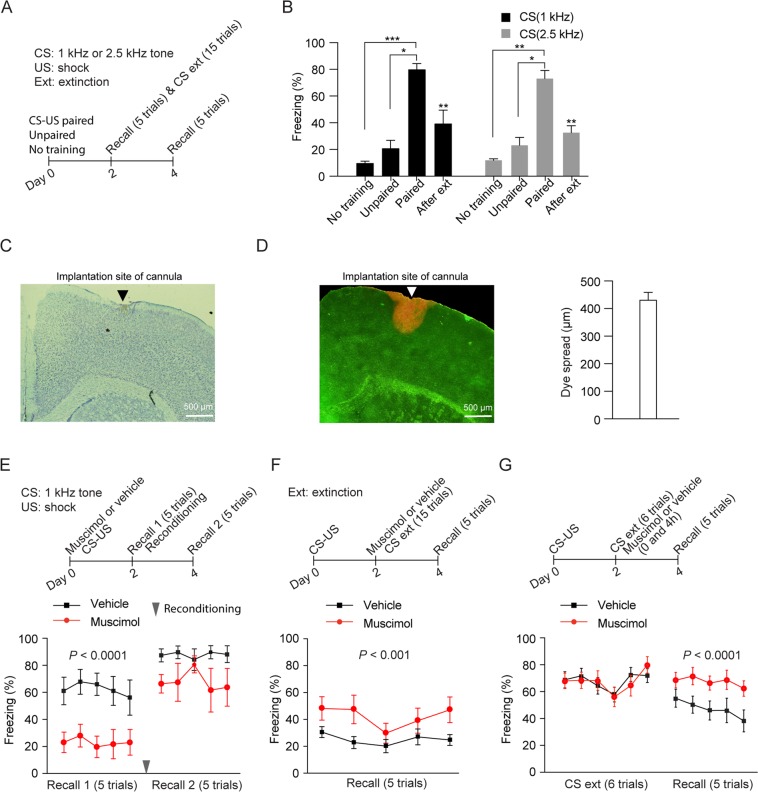Figure 1.
Inactivation of the primary motor cortex impairs conditioned freezing and extinction. (A) Schematic of experimental design. Mice were subjected to CS (1 or 2.5 kHz auditory tone) paired with US, unpaired stimuli or no training on day 0. These mice were subjected to recall test on day 2. The mice subjected to CS-US pairings were further subjected to fear extinction on day 2 and to recall test on day 4. (B) Mice subjected to CS-US pairings showed higher freezing response compared to mice subjected to unpaired stimuli and no training during the recall test on day 2. Fear extinction significantly decreased the conditioned freezing during the recall test on day 4 (n = 8 and 6 mice for CS (1 kHz)-US paired and extinction groups; n = 6 and 5 mice for CS (2.5 kHz)-US paired and extinction groups; n = 4–6 mice for unpaired and untrained groups). The average freezing response of 5 trials during the recall test was used in the comparison. (C) Nissl staining revealed the cannula position in the primary motor cortex. (D) Left: a representative brain section from YFP-expressing mice infused with Congo red through injection cannula inserted into the primary motor cortex. Right: the dye spread was determined by measuring mediolateral extent of Congo red in slice (n = 4 mice). (E) Top: schematic of experimental design. Muscimol (1 µl, 1 µg/µl) or vehicle was infused bilaterally into the primary motor cortex prior to fear conditioning by pairings CS (1 kHz auditory tone) and US on day 0. The same mice were subjected to recall test and reconditioning on day 2 and to recall test on day 4. Bottom: bilateral infusion of muscimol into the motor cortex before fear conditioning significantly reduced freezing during the recall test on day 2 (n = 10 and 7 mice for muscimol and vehicle groups respectively). After reconditioning, muscimol-infused mice showed higher freezing response during recall test on day 4 when compared to that on day 2 (n = 5 and 3 mice for muscimol and vehicle groups respectively during recall test on day 4). The freezing response of each trial during the recall test was used in the comparison. (F) Top: schematic of experimental design. Mice were subjected to CS-US pairings on day 0 and CS extinction with 15 tone presentations on day 2. Muscimol or vehicle was infused bilaterally into the primary motor cortex 1 hour before CS extinction on day 2. The same mice were subjected to recall test on day 4. Bottom: bilateral infusion of muscimol into the motor cortex before CS extinction significantly reduced freezing during the recall test on day 4 (n = 7 and 8 mice for muscimol and vehicle groups respectively). The freezing response of each trial during the recall test was used in the comparison. (G) Top: schematic of experimental design. Mice were subjected to CS-US pairings on day 0 and CS extinction with 6 tone presentations on day 2. Muscimol or vehicle was infused bilaterally into the primary motor cortex after extinction (twice, immediately and 4 hours) on day 2. The same mice were subjected to recall test on day 4. Bottom: after extinction, muscimol-infused mice showed significantly higher freezing during the recall test than vehicle-infused mice on day 4 (n = 9 and 10 mice for muscimol and vehicle groups respectively). Data are presented as mean ± S.E.M. *P < 0.05; **P < 0.01; ***P < 0.001.

